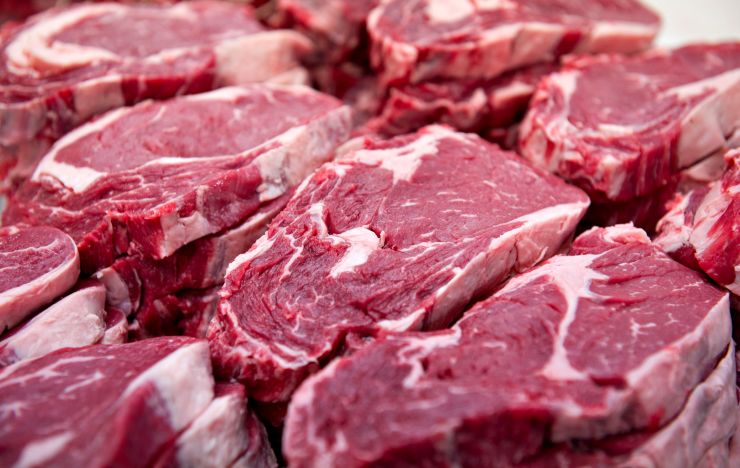In 2005, Japan imposed restrictions on cattle over 30 months old for U.S. beef imports in response to the outbreak of bovine spongiform encephalopathy, sometimes known as
mad cow disease.
According to the USDA announcement, Japan agreed to remove that age limit for U.S. beef imports. The new terms, which take effect immediately, allow U.S. products from all cattle, regardless of age, to enter Japan for the first time since 2003, the government said.“This is great news for American ranchers and exporters who now have full access to the Japanese market for their high-quality, safe, wholesome, and delicious U.S. beef,” Agriculture Secretary Sonny Perdue said in a statement. “We are hopeful that Japan’s decision will help lead other markets around the world toward science-based policies.”
American beef sales to Japan topped $2 billion last year, representing approximately one-fourth of all U.S. beef exports.
The U.S. Meat Export Federation estimates that expanded access without the age restrictions could increase U.S. beef sales to Japan 7% to 10%, or by $150 million to $200 million annually. It said the ability of the industry to use beef from over-30-month cattle also will lower costs for companies exporting processed beef products to Japan.
On the news, Chicago Mercantile Exchange cattle futures moved higher, reversing some recent weakness. The August feeder cattle contract was up more than 1%, and the August live cattle contract also was slightly higher.
“There are countries and regions where it takes decades to build up to $200 million in beef exports,” said Joe Schuele, a spokesman for USMEF. “And yet in Japan, we’re going to add that business in really a short period of time. So in a way, this is kind of like opening up a whole new medium-sized market.”
Japanese regulators banned imports of U.S. beef and beef products in 2003 in response to mad cow disease being confirmed on a farm in Washington state. In late 2005, Japan agreed to restore partial access to U.S. beef but with age-based restrictions.
The U.S. is Japan’s largest beef supplier in terms of value and ranks second behind Australia in volume. Still, export competition is intensifying as New Zealand, Canada and Australia get reduced Japanese tariffs under the Trans-Pacific Partnership, the 11-nation trade deal the U.S. withdrew from in 2017 under President Donald Trump.
“Tariff rates grab all the headlines, but non-tariff barriers are often just as important, if not more so, when it comes to determining market access,” said National Cattlemen’s Beef Association President Jennifer Houston. “Hopefully, this will help spotlight this important point and lead to more trade victories in the near future.”


Key Points
Japan has agreed to lift longstanding restrictions on American beef exports, clearing the way for U.S. products to enter the market regardless of age, the U.S. Department of Agriculture announced Friday.
The news comes on the heels of other important trade developments on Friday, including the Trump administration’s plans to delay auto tariffs on the EU and Japan and lift steel tariffs on Canada and Mexico.
According to the USDA announcement, Japan agreed to remove that age limit for U.S. beef imports. The new terms, which take effect immediately, allow U.S. products from all cattle, regardless of age, to enter Japan for the first time since 2003, the government said.“This is great news for American ranchers and exporters who now have full access to the Japanese market for their high-quality, safe, wholesome, and delicious U.S. beef,” Agriculture Secretary Sonny Perdue said in a statement. “We are hopeful that Japan’s decision will help lead other markets around the world toward science-based policies.”
American beef sales to Japan topped $2 billion last year, representing approximately one-fourth of all U.S. beef exports.
The U.S. Meat Export Federation estimates that expanded access without the age restrictions could increase U.S. beef sales to Japan 7% to 10%, or by $150 million to $200 million annually. It said the ability of the industry to use beef from over-30-month cattle also will lower costs for companies exporting processed beef products to Japan.
On the news, Chicago Mercantile Exchange cattle futures moved higher, reversing some recent weakness. The August feeder cattle contract was up more than 1%, and the August live cattle contract also was slightly higher.
“There are countries and regions where it takes decades to build up to $200 million in beef exports,” said Joe Schuele, a spokesman for USMEF. “And yet in Japan, we’re going to add that business in really a short period of time. So in a way, this is kind of like opening up a whole new medium-sized market.”
Japanese regulators banned imports of U.S. beef and beef products in 2003 in response to mad cow disease being confirmed on a farm in Washington state. In late 2005, Japan agreed to restore partial access to U.S. beef but with age-based restrictions.
The U.S. is Japan’s largest beef supplier in terms of value and ranks second behind Australia in volume. Still, export competition is intensifying as New Zealand, Canada and Australia get reduced Japanese tariffs under the Trans-Pacific Partnership, the 11-nation trade deal the U.S. withdrew from in 2017 under President Donald Trump.
“Tariff rates grab all the headlines, but non-tariff barriers are often just as important, if not more so, when it comes to determining market access,” said National Cattlemen’s Beef Association President Jennifer Houston. “Hopefully, this will help spotlight this important point and lead to more trade victories in the near future.”